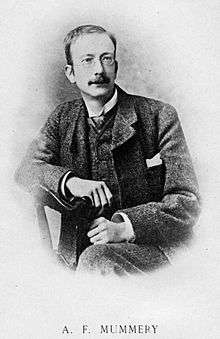Albert F. Mummery
| Albert F. Mummery | |
|---|---|
 | |
| Born |
10 September 1855 Dover, England |
| Died |
24 August 1895 (aged 39) Nanga Parbat, Pakistan |
| Occupation | Mountaineer, Author |
| Spouse(s) | Mary |

Albert Frederick Mummery (10 September 1855, Dover, Kent, England – 24 August 1895, Nanga Parbat), was an English mountaineer and author. Although most notable for his many and varied first ascents put up in the Alps, Mummery, along with J. Norman Collie, Hastings, and two Gurkhas are also known to have been the first men in recorded history to have attempted to summit one of the Himalayan eight-thousanders - the fourteen highest peaks in the world.
Their innovative, light-weight endeavour upon Nanga Parbat in 1895 was to prove ill-fated with Mummery and both Gurkhas having perished in an avalanche whilst reconnoitering the mountain's Rakhiot Face. The mountain would go on to earn its reputation as a "man-eater," as thirty-one men would lose their lives on its slopes before the first ascent was made by the legendary Austrian Mountaineer, Hermann Buhl, in 1953. Buhl described Mummery as "One of the greatest mountaineers of all time".[1]
Life
Mummery's father was a tanner and mayor of Dover. The tanning business was prosperous enough for Mummery to devote most of his energies to climbing and economics. He became a friend of J. A. Hobson, and they collaborated on The Physiology of Industry (1889), which argued that because of economies' tendencies towards over-saving - and this being a cause of depressions – the economy required intervention to achieve stability.[2]
Mountaineer
Mummery is best remembered for his pioneering efforts in mountaineering. Initially, he climbed with mountain guides, but with his companions William Cecil Slingsby and J. Norman Collie he was part of the movement which revolutionized alpinism by the practice of guideless climbing. He invented the Mummery tent, a type of tent used in the early days of mountaineering.
He made a series of remarkable first ascents, most notably the Aiguille du Grépon (which features a crack named after him), the Dent du Requin, the Grands Charmoz, the Teufelsgrat on the Täschhorn, the Dürrenhorn and the Zmutt ridge of the Matterhorn, which he ascended on 3 September 1879 with the guides Alexander Burgener, J. Petrus and A. Gentinetta. In 1894, he led his friend, the young Duke of the Abruzzi, to the top of the Matterhorn by the same route.
Mummery occasionally climbed with his wife Mary, or with her friend Lily Bristow.
In 1880, Mummery and Burgener were repelled while trying to make the first ascent of the much-coveted Dent du Géant, being forced back by some difficult slabs. This provoked Mummery to exclaim prophetically: 'Absolutely inaccessible by fair means!'[3]
In 1895, Collie, Hastings and Mummery were the first climbers to attempt the Himalayan 8,000 metre peak, Nanga Parbat, the ninth highest mountain in the world. On this pioneering lightweight expedition, the mountain claimed the first of its many victims, when Mummery and two Gurkhas, Ragobir Thapa and Goman Singh, fell and were killed by an avalanche while reconnoitering the Rakhiot Face. Their bodies were never found. The story of this disastrous expedition is told in J. Norman Collie's book From the Himalaya to Skye.
Mummery left behind him a legacy of some of the most well-regarded routes in the Alps, and also, in his book My Climbs in the Alps and Caucasus, one of the enduring classics of mountaineering literature.
It has frequently been noticed that all mountains appear doomed to pass through the three stages: An inaccessible peak - The most difficult ascent in the Alps - An easy day for a lady.— Albert Frederick Mummery, My Climbs in the Alps and Caucasus
References
- ↑ Hermann Buhl, È buio sul ghiacciaio, con i diari alle spedizioni al Nanga Parbat, al Broad Peak e al Chogolisa, a cura di Kurt Diemberger, Corbaccio, 2007, ISBN 978-88-7972-871-3; pag. 243 e pag. 261
- ↑ Bleaney, M (1998) Mummery, Albert Frederick: in The New Palgrave Dictionary of Economics. eds Eatwell et al
- ↑ Dumler, Helmut, and Willi P. Burkhardt, The High Mountains of the Alps (London: Diadem, 1994) p. 179
- Collie, J. Norman. From the Himalaya to Skye. Rockbuy Limited. ISBN 1-904466-08-7.
- Mummery, A. F. My Climbs in the Alps and Caucasus. Rockbuy Limited. ISBN 1-904466-09-5.
External links
- Peter H. Hansen, ‘Mummery, Albert Frederick (1855–1895)’, Oxford Dictionary of National Biography, Oxford University Press, 2004
|